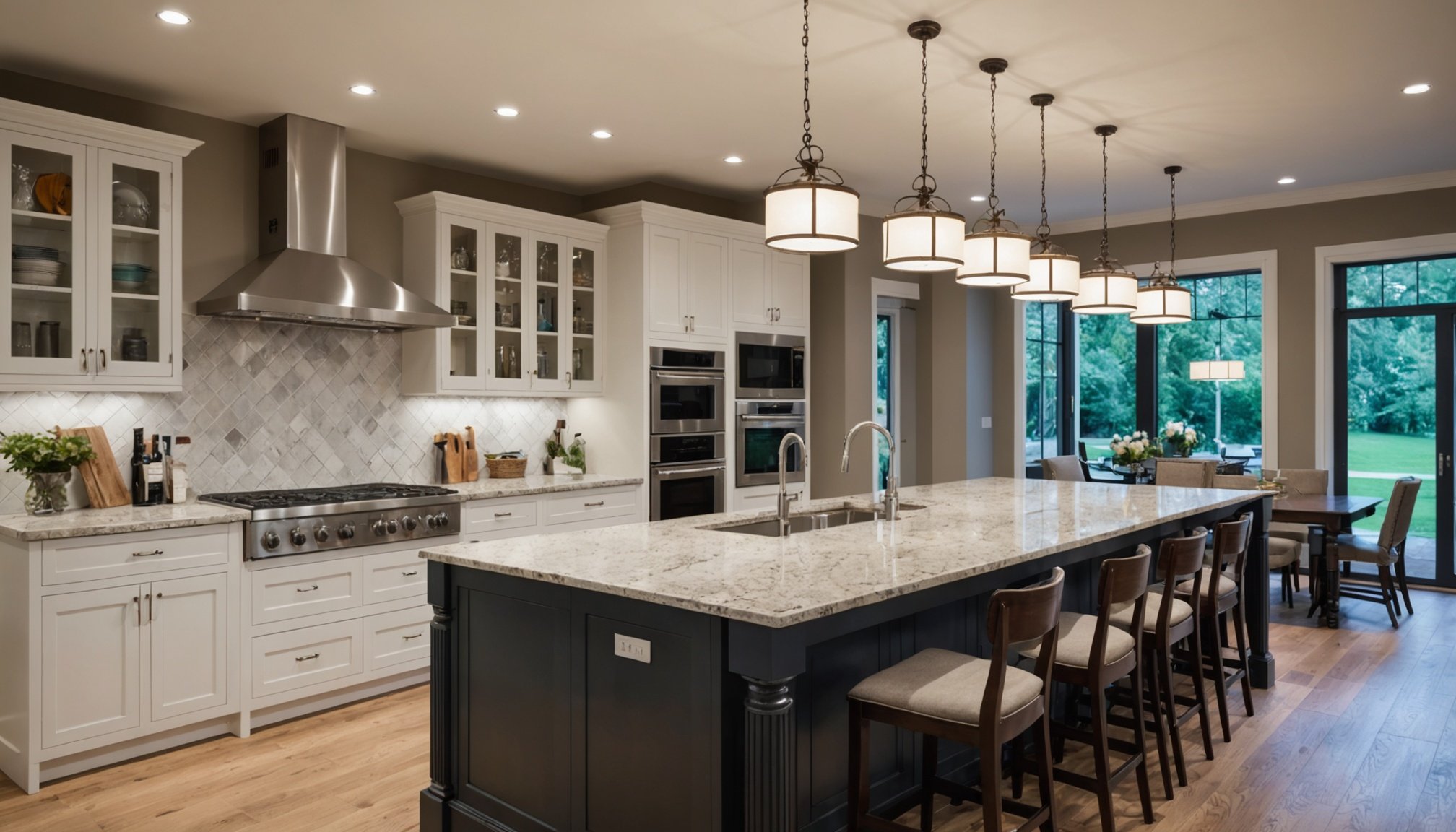Overview of Kitchen Island Lighting Options
Choosing the appropriate kitchen island lighting options is crucial for creating both functionality and style in your cooking space. The key is understanding the types available, such as pendant, recessed, and task lighting, and how each can influence your kitchen’s ambience.
Types of Lighting
Pendant lighting is a popular choice, offering both decorative appeal and practical illumination. It hangs from the ceiling, creating a focal point above the island and allowing for various styles and materials to match personal tastes.
In parallel : Ultimate guide to installing an exceptional kitchen ventilation system for your uk home
Recessed lighting, on the other hand, is subtle and sleek, embedded in the ceiling to provide understated yet effective light. This option is ideal for those seeking a minimalist aesthetic or to complement more modern kitchen designs.
Task lighting specifically targets areas where you perform tasks, ensuring that you have the necessary brightness to work efficiently. In the kitchen, this might involve strategically placed lights to illuminate chopping boards or cooking surfaces.
This might interest you : Unlock culinary precision: the ultimate guide to selecting the ideal kitchen timer in the uk
Importance of Selection
Your choice among these types of lighting should reflect the kitchen’s layout and your personal style. A well-thought-out lighting design not only enhances functionality but also elevates the kitchen’s overall visual appeal. It’s essential to visualize the impact of each lighting type to make an informed decision that balances aesthetics and practicality.
Factors to Consider When Selecting Lighting
When choosing lighting for your space, several factors can impact the final decision. One key consideration is the kitchen island size. Lighting fixtures must be proportionate to ensure balanced illumination, without overwhelming the area. Assess the dimensions of your kitchen island to select fixtures that complement and enhance the space.
Understanding Light Brightness
Brightness levels play a crucial role in setting the kitchen ambiance. The intensity of light affects the overall mood and practical functionality of the kitchen. Opt for fixtures that allow adjustability in brightness to cater to different needs—be it a dimmed atmosphere for intimate dinners or full brightness for detailed food preparation.
Balancing Style and Function
While aesthetics are essential, it is crucial to balance style preferences with functional lighting needs. Consider fixtures that marry your design taste with practical functionality. Evaluate the compatibility of fixture design with the kitchen decor to ensure a cohesive look, without sacrificing the lighting efficacy.
To summarise, selecting appropriate lighting involves considering the kitchen island size, desired brightness levels, and a blend of style with practicality. These factors ensure that your kitchen remains both a functional and visually appealing part of your home.
Style and Design Trends in the UK
In the UK, kitchen lighting trends have evolved to highlight the importance of both style and functionality. Modern kitchen island lighting typically features sleek designs with clean lines and minimalistic features, often incorporating LED technology for energy efficiency. Popular choices include pendant lights and recessed lighting, which provide a contemporary look and fulfil practical lighting needs.
In contrast, traditional styles lean towards more ornate and elaborate fixtures, such as chandeliers or vintage-inspired lanterns, offering a nod to historical elegance. These designs often incorporate warm-toned bulbs to complement the rich textures and colours found in classic kitchen interiors.
Blending lighting designs to suit overall kitchen aesthetics can seem daunting but is achievable with thoughtful planning. For instance, combining elements from both modern and traditional styles can create a unique transitional feel. Consider integrating industrial-style pendant lights with traditional wooden cabinetry to harmonize opposing elements.
Focusing on key areas like kitchen islands allows for both statements and task lighting, enhancing both form and function. Regardless of the style preference, the aim is to create a well-lit space that reflects personal taste while ensuring efficiency and comfort. This balance can transform a kitchen from merely functional to a focal point of home design.
Installation Tips for Kitchen Island Lighting
When it comes to kitchen lighting installation, a clear plan can make all the difference. Begin with a step-by-step approach to ensure a smooth process. Start by deciding the type of lighting—pendants, chandeliers, or recessed lights—and their placement above the island. Each fixture type has unique requirements; for instance, pendant lights typically need to be spaced approximately 30 inches apart for optimal illumination.
Electrical Considerations
Safety is paramount. Before beginning, make sure all power sources in the kitchen are turned off to avoid any risk of electric shock. The circuit supporting your kitchen island lighting must be capable of handling the additional load; consider consulting an electrical diagram of your home if in doubt. When working with electricity, understanding wire connections and having the right tools (such as voltage testers and wire strippers) is crucial.
DIY vs. Professional Installation
DIY lighting installation can be satisfying and cost-effective but requires a precise understanding of electrical considerations and proper safety practices. On the other hand, hiring a professional provides peace of mind, ensuring that all codes and standards are met and saving you the potential hassle of trial and error. Assessing your comfort level with electrical tasks can guide your decision.
Choose wisely to enjoy both the aesthetic and functional benefits of your illuminated kitchen space.
Budgeting for Kitchen Island Lighting
When it comes to planning your kitchen lighting budget, understanding various price ranges is crucial. Kitchen island lighting fixtures vary considerably in cost, depending on factors like design, materials, and brand. For instance, a basic pendant light can cost as little as £30, while high-end designer options may exceed £300. Recognising these differences ensures you allocate funds appropriately and make informed decisions.
Finding affordable options that don’t compromise on style requires a bit of research and creativity. Consider shopping during sales or discount seasons, exploring online marketplaces, or visiting local thrift stores for unique finds. Many retailers offer budget-friendly versions of popular designs, providing stylish solutions without breaking the bank. Prioritising value for money is essential in making your selection.
Value for money in lighting selections isn’t solely about cost; it also involves evaluating durability, energy efficiency, and aesthetic appeal. Look for fixtures made from durable materials, with energy-efficient bulbs that stand the test of time. Checking product reviews can offer insights into the longevity and performance of the item, ensuring your kitchen lighting budget is well-spent. You’ll enjoy both style and substance without overspending.
Product Recommendations and Visual Examples
When selecting the best kitchen island lighting, it’s essential to base choices on trusted product reviews. In the UK, several recommended kitchen lights satisfy both aesthetic appeal and functionality. For instance, pendant lights have gained popularity for their versatility and elegant designs.
Top-rated Kitchen Lights
-
Industrial Pendant Lights: Known for their robust construction, these lights are popular for adding a rustic charm. They often feature a mix of metal and glass components, providing both style and durability.
-
Chandeliers: These are perfect for a touch of sophistication. Sleek, modern designs combine traditional elegance with contemporary flair.
-
LED Track Lighting: An energy-efficient choice, offering adjustable fixtures for targeted lighting. Ideal for illuminating specific areas of your kitchen island.
Visual Examples
Visualizing these recommended kitchen lights in real settings can aid decision-making. Pictures showing installations above kitchen islands highlight how these lights impact the overall ambiance. Such examples demonstrate not only style but also layout flexibility.
Pros and Cons
Each lighting fixture comes with distinct advantages. For example, pendant lights offer adjustable height, whereas chandeliers provide wide-spread illumination. However, installation complexity and maintenance requirements can be drawbacks. Consider these pros and cons to find fixtures that align with your needs.
Choosing the right kitchen lighting elevates the space’s visual appeal and functionality.











